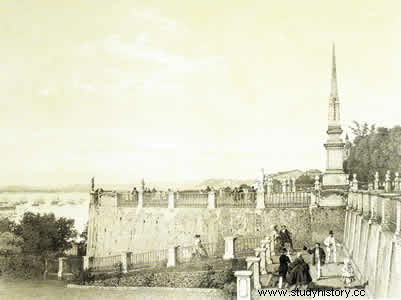
Salvador, capital of the province of Bahia, was the scene of numerous rebellions since the end of the 18th century and throughout most of the 19th century. The Conjuração Baiana, in the 1790s, possibly marked the beginning of these rebellions against the established authorities, with the struggles for independence and several other revolts in the 1820s and 1830s. In 1858, there was another one, this time with part of the population. of the city taking to the streets and echoing the cry of “boneless meat and pitted flour”. The episode, which became known as the Flour Revolt , took place on February 28, 1858.
The population of the city of Salvador and other cities in the province suffered a few years before an intense drought, which affected the production of manioc flour, there were still some epidemics such as cholera-morbus, which killed around ten thousand people between 1855 and 1856. In addition to the climate created in the population, one of the medical recommendations was that the population should stop eating imported meat. from the Rio da Prata region and start eating more of the so-called green meat, considered healthier.
The two processes mentioned above have caused the price of these foodstuffs to rise considerably, increasing the percentage of income allocated to food. There was still another problem, which was the control exercised over the sale of products by some Portuguese traders, who ended up exercising a kind of monopoly in distribution, as they acted as intermediaries between producers and retailers.
The hostility of the Soteropolitan population towards the Portuguese came for a long time and, at a time when inflation reached the products they sold, tension increased. However, this time, the target of the crowd that took to the streets was not the Portuguese, but the state authorities.
A few more factors contributed to the Flour Revolt. One of them was the political dispute over the definition of the places where cassava flour was sold. At the beginning of 1857, the Municipality of Salvador had published a pronouncement, a municipal law, which defined that cassava flour should be sold only in the Municipal Celeiro and in some granaries authorized by the Chamber, thus intending to control the price of the product. , pressing for its drop.
The president of the province of Bahia at the time was José Lins Vieira Cansanção de Sinimbu , future Viscount of Sinimbu, who would still become head of the government of D. Pedro II. Initially, Sinimbu authorized the pronouncement. However, he reversed the authorization, due to pressure from traders, and sent the measure to the Provincial Assembly for evaluation. Sinimbu was educated in Europe and an adherent of economic liberalism.
The measure proposed by the City Council was a form of State control over the economy, violating the free-competitive principles of liberalism, which postulates that prices vary according to the law of supply and demand. Increased competition leads to lower prices. These were the arguments used by Sinimbu.
The City Council waited for a response from the Provincial Assembly for several months. Faced with the silence, he decided to reissue the measure, which led to a crisis between municipal and provincial powers. Police officers constantly clashed with the Chamber's inspectors, who wanted to control the sale of manioc flour.
According to chroniclers of the time, who lived in Salvador, the population followed the discussions and commented in taverns, barbershops and other public places. There was also an opposition to the Sinimbu government, possibly organized clandestinely and which presented its positions through materials posted on the city's walls.
In this climate, the Flour Revolt broke out on February 28, 1858, a Sunday in Lent. But the trigger for the revolt was not foodstuffs. At the time, the inmates of the Santa Casa de Misericórdia, single orphans, generally poor, suffered mistreatment by the French nuns of São Vicente de Paulo, hired to educate them. The screams given by the collected from the windows of the Santa Casa reached the ears of young men who were in the region, who quickly volunteered to help them, and entered the building.
After the nuns were escorted to another location, more people joined the group. The demonstration turned into a protest against the famine, leading the people to shout the slogan, “boneless meat, pitted flour”. They headed for the government palace, where they stoned the building. They also passed the Town Hall and occupied it. The protesters still climbed the tower and with the ringing of the bells called more people to demonstrate against Sinimbu.
The cavalry of the police force was called to disperse the crowd with sword blows and the hoofs of horses. The population reacted with stones, and the conflict lasted a few hours. The following day, new conflicts occurred, with the population occupying the City Hall again.
Most of its councilors were substitutes, due to the suspension given by Sinimbu to some councilors as a result of the pronouncement he annulled. Police forces removed the protesters from the building, and the provincial president's decision was voted in favour. He had the support of the Salvador Commercial Association, which openly defended free trade, guaranteeing the control of middlemen in the sale of manioc flour.
The sum of events gave the Revolt a political character, overcoming the issue of price increases. In June, Sinimbu left the presidency of the Province. The new president approved the House's position and state control over the sale of the product, but did not solve the problem of high prices.
